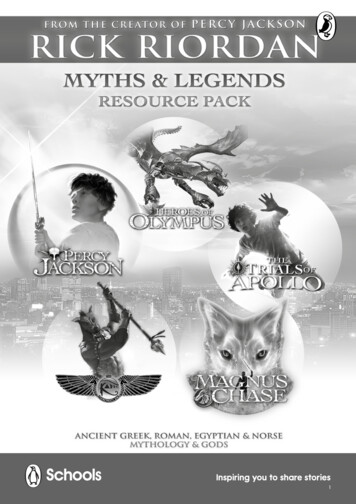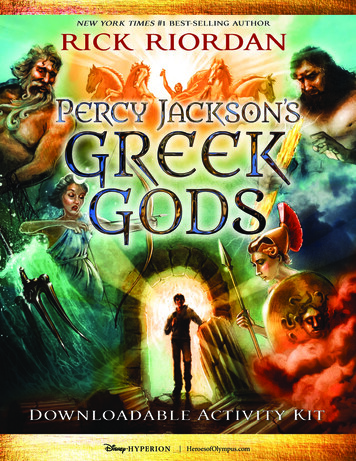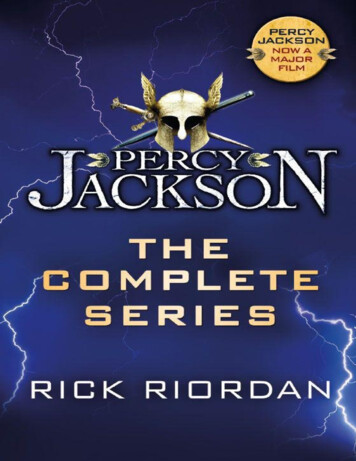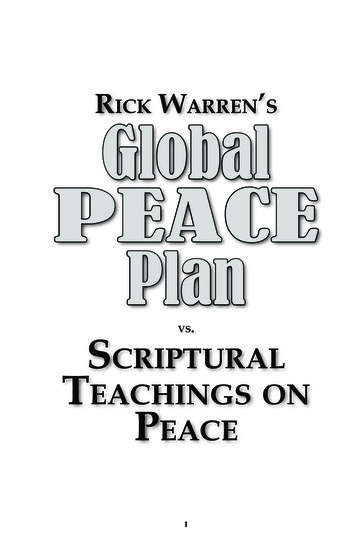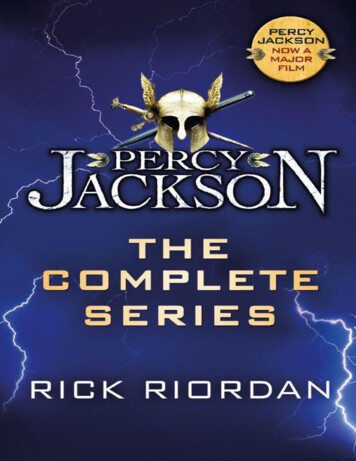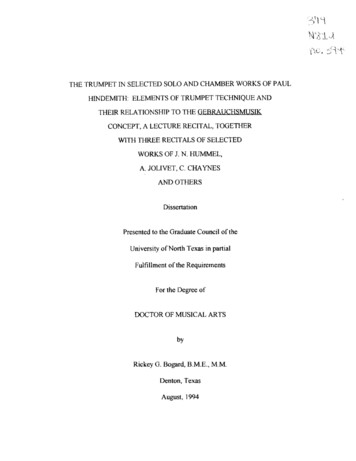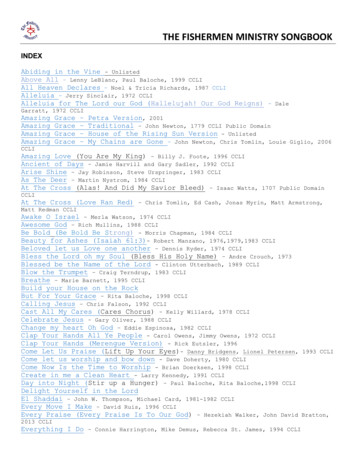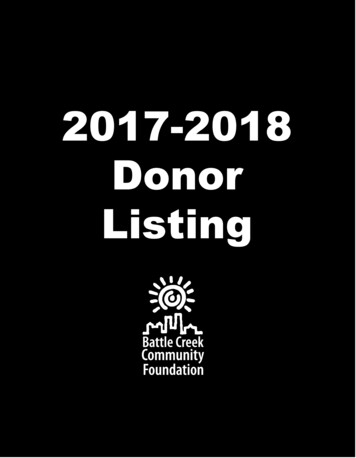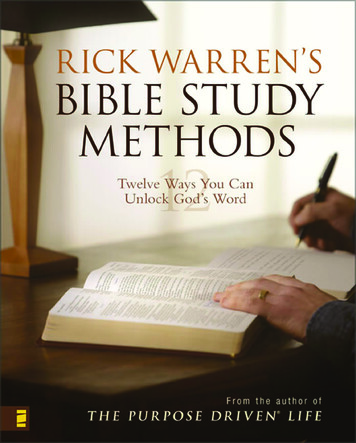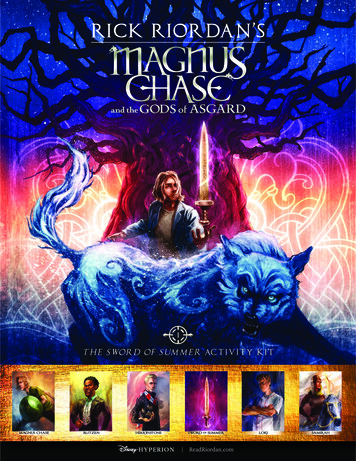
Transcription
RICK RIORDAN ’ST H E SWOR D OF SUM M ER Ac t i v it y k itmagnus chaseblitzenhearthstonesword ofsummerReadRiordan.comlokisamirah
Sword of Summer Party IdeasDECORATING IDEAS: In The Sword of Summer, Magnus Chase finds himself in Valhalla. Toprepare for your Magnus Chase and the Gods of Asgard event, introduce the atmosphere of theNorse longhouse into your space. Backdrops of log walls, evergreen forests, and snowy hillsides willget attendees into the spirit of the journey Magnus Chase takes. Use butcher paper to create yourbackdrops; adding to the scene with a profile of a longboat deck and the Rainbow Bridgeto Asgard will help create the scene for the party.A NORSE FEAST: Building a civilization (or being the godsworshipped by it) in the frozen climes of far northern Europe ishard work! The Norse offset the cold climate and frequent combatwith hearty feasts, so entice your partygoers with a wide variety offoods inspired by Magnus Chase and the Gods of Asgard. To begin,offer treats with a nod to Scandinavian flair, such as Swedish Fish,Swedish meatballs, Danishes, peppermint and spearmint gum,oatmeal cookies, “lefse” (a sweet or savory flatbread you can representwith chips), “seagull eggs” (malt balls), Warheads, and “mead”(ginger ale or lemonade). Follow these with a spread fit for a healthyViking by offering a choice of fruits, veggies, and nuts (labeled andseparated, of course—you don’t want to trigger any allergies).VIKING HORN BUGLES: For this game,participants circle. Have one of them start therumor ring with a two-to-three-sentence storyexcerpt, character summary, or plot blurb fromThe Sword of Summer or one of the Heroes ofOlympus or Kane Chronicles books (if attendeeshaven’t yet read book one of Magnus Chase andthe Gods of Asgard). Each participant whispersthe story to the person to their right, and whenit has made the full circuit, the last personannounces what was whispered to them forcomparison with the original statement.
Armed for BattleThe Norse peoples were famous in history for being fierce warriors who terrified those whomight fall to one of their raids. But every Viking needs armament! Ask each party participant todesign a sword, a shield, or a helmet featuring an original logo and symbol to serve as a sourceof strength and protection in battle. Provide markers, paint, glitter, glue, tape, constructionpaper, cardboard, and the like for the task. Spirit animals such as bears, wolves, foxes, serpents,dragons, owls, eagles, and fish were popular among the Norse, as were symbols of raw power innature such as lightning, fire, mountains, and the sea. Symbols of the gods, of course, were verypopular as well. Encourage participants to think out of the box and use a symbol that fits theirown personal style and worldview.
Viking VerbageThe Norse developed a distinctive writing system known as runes, a system that combined ideographic writingsymbols that were applied to the sounds of the Norse languages. Download copies of the Norse runic alphabet andprovide materials for participants to create nameplates for themselves, write a note to their parents, or redesignthe artwork for a favorite book, musician, band, or sports team using runes in the names.RUNIC WORD SCRAMBLE: Use runic alphabet symbols for the following clues.1. N orse sailing vessels known asto sail both on the seas and up shallow rivers.allowed traders and raiders2. N orse explorers established colonies on the islands ofand.3. V iking warriors fought fiercely and bravely in battle in hopes that they would be.allowed into the great hall of the afterlife,4. W hile the Vikings, homelands were in Scandinavia, there were long periods of Norse,rule over parts of, and.5. W hile the Vikings were notorious warriors, they were also some of medieval Europe’s.1. Longboats 2. Greenland and Iceland 3. Valhalla 4. England, France, and Russia 5. MerchanrtsANSWERS:most active
Many Worlds,,One TreeThe Norse cosmology was contained in a great tree, the world tree Yggdrasil. The various levels of thetree held what the Norse saw as nine realms of existence for all of the beings of the universe. How mightyou organize such a world? Provide participants with a reproducible sheet of the World Tree, and havethem place each of the following realms within the tree in the place where they think it fits best. Theymight include illustrations to signify the realm. Once they are finished, have them compare their treesto an artist’s representation (many of these can be found online).Asgard (Level 1): brilliantly lit realm of the civilized godsof order and stability, and of Valhalla, the hall of the greatwarriors of the human race.Svartalfheim (Level 3): realm of the dwarves and darkcreatures such as trolls. They are associated with mining,blacksmithing, and caves.Vanaheim (Level 2): idyllic realm of the gods of agriculture,hunting, and the bounty of nature.Jotunheim (Level 3): realm of the frost giants, the ancient andwild creatures at the edge of Yggdrasil who are the greatest threatto both the gods and man.Alfheim (Level 2): realm of the white elves, luminousdemigods linked to magic and the beauty of nature.Midgard (Level 3): the realm of man, which is encircled by agreat serpent that both contains the human world and preventsdirect intrusion from the surrounding realms. It is usuallyassociated with the trunk of the tree.Bifrost: the rainbow bridge that occasionally connects theworlds of Asgard and Midgard.Niflheim (Level 3): land of frost, mist, ice, and themountainous cold of the Norse world.Muspelheim (Level 3): land of fire, steam, and volcanoes.Well of Urd (Level 4): ground spring of water that is the sourceof life for Yggdrasil.Helheim (Level 5): the place of the dead, the unseen worldusually associated with the roots of Yggdrasil.
History or LegendHow much do you know about the Norse and Germanic worlds? Look at the statements belowand circle “History” if you think the statement is true, or “Legend” if you think it is false.1. In spite of many efforts, the Scandinavian and Germanic worlds were among the few in Europenever to be conquered by the Roman Empire.LEGENDHISTORY2. Viking warriors wore helmets with large horns to scare their enemies in battle.LEGENDHISTORY3. In order to go to Valhalla in the afterlife, one had to live a good and productive life.LEGENDHISTORY4. Viking sailors reached the shores of the Americas almost 500 years prior to ChristopherColumbus.LEGENDHISTORY5. The Norse were a warrior civilization who had to raid neighboring regions forresources since Scandinavia was too cold for farming.LEGENDHISTORY6. Thanks to abundant forests and because of the cold climate, the Norse peopleconstructed elaborate tree houses for shelter.LEGENDHISTORY7. Though commonly associated with evil, the Norse god Loki was actually associatedmore with trickery and mischief and could be involved in harm or good dependingon his view of the situation.LEGENDHISTORY8. The Norse people celebrated a holiday similar to Christmas.LEGENDHISTORY9. Thor, the Norse god of thunder and lightning, was the king of theNorse gods.LEGENDHISTORY10. Norse women and girls enjoyed many more rights and freedomsthan most other women in Europe in their time.LEGENDHISTORY11. The Vikings were a strong empire who ruled most ofnorthern Europe in the Middle Ages.LEGENDHISTORY12. Most of the days of the week are named after Norse godsand goddesses.in the English language.LEGENDHISTORY1. History-Rome’s failure to conquer north central Europe—in spite of several tries—resulted in a great cultural split in Europe between a Roman-influencedsouth and west and a Germanic-influenced north and east 2. Legend-horned helmets were used in costumes of 18th/19th Cent. plays and operas, but Vikingsoldiers never actually wore them in battle 3. Legend-Valhalla was reserved for those who died bravely in battle 4. History-Evidence of Viking settlements onthe east coast of Canada date back to at least the 1000’s AD 5. Legend-Scandinavia actually supported very productive agriculture, and Norsemen were activetraders all over the Europe 6. Legend-an interesting idea, but northern European peoples lived in homes made of wood, stone, or sometimes sod) 7. Historythough Loki was usually causing trouble, the Norse religion didn’t really put their beliefs in terms of good and evil—just troublesome and not troublesome8.History-the feast of Yule {mid-winter} was celebrated on Dec. 20-21, and was a day of merriment, feasting, and gift giving. After most of Scandinavia wasChristianized in the 10th Cent. AD, they celebrated the religious holiday of Christmas 9. Legend-though Thor was associated with the same powers in nature asZeus in Greece and Jupiter in Rome, his father Odin was actually the king of the Norse gods 10. History-though not given equal rights as men, Norse women hada lot of social and economic freedom due to their husbands being gone for long stretches of time 11. Legend- the Vikings lived as small tribal groups that didn’tconsider themselves united in any way with other Norse groups 12.History-only Sunday, Monday, and Saturday have Roman roots in the English languageANSWERS:
Explore With the NorsemenThe Norse were active traders and explorers, extending their presence to the far reaches of Europe aswell as to North Africa, Russia, and across the Atlantic Ocean. Read the descriptions below and locateeach historically significant place on the map of the Norse-influenced world. Write the letter of thelocation in the blank space next to its description.1. S candinavia, the present-day countries of Denmark, Sweden, andNorway and the heart of the Norse world10. U sing river systems, the Norse were able to raid the largest city innorthern Europe2. R emote Swedish Viking trade post that became the center of an activetrade in timber, furs, honey, and slaves11. R aids were so successful in this region of northern France thatthe Norse were able to set up a kingdom from which they wouldeventually invade England3. G reatest of the Norse settlements in Russia, this city would becomethe hub for trade with the Byzantine Empire and the IslamicCaliphates12. N orwegian Vikings established rule over this region composed ofsouthern and eastern Ireland and much of Wales and Cornwall4. N orse merchants brought highly prized northern goods to this greatcapital of the Islamic Caliphates13. S ome of the most infamous Viking raids in history led to Danish ruleover much of the east coast of England5. After a rocky start to their relationship, Viking links to the capitalof the Byzantine Empire eventually made that culture the greatestinfluence on Russian civilization14. N orwegian Viking control over the north coast of Scotland allowedfor further exploration across the Atlantic6. F rom a colony outside of this ancient North African city, Norse sailorsextended trade and later ferried Crusaders to the Holy Land7. A successful raid on Palermo led to a short period of Norse rule overthis island off of the coast of Italy15. O vercrowding and limited farmland in Scandinavia probablyprompted Norse colonization of this Atlantic Ocean island16. T hough today its massive glacier makes its name seems strange, awarmer climate in the tenth century left productive farmland forIcelandic Viking settler Erik the Red8. T he Pope was so terrified of a Viking raid on this holy city that he fledto his fortress in the Alps9. W hile Spain and Portugal were under Arab rule, Norse raidersrepeatedly attacked these wealthy cities and even occupied one for ashort timeandA. GreenlandB. IcelandF. VikingHomelandsC. OrkneyD. BretlandG. NovgorodE. DanelawH. NormandyI. ParisJ. KievL. RomeM. ConstantinopleK. LisbonP. SicilyO. TunisQ. Baghdad1. F 2. G 3. J 4. Q 5. M 6. O 7. P 8. L 9. K and N 10. I 11. H 12. D 13 .E 14. C 15. B 16 .AANSWERS:N. Sevillle
Sword of Summer ScrambleOh no! The gods have mixed up the letters for these key words from Magnus’s quest! Unscramble andmatch the highlighted letters below to solve the bonus question: What is the Sword’s true Norse name?EXAMPLE:SMAGNU M A G N U S1. SNROE2. URST3. AMISAHR4. HHTTNEEAORS5. ROTH6. ZNTIEBL7. RNHEEIARJ8. LAHLAAVL9. GNTAI10. DOGS11. ERYF12. RKELAIYV123456789101112HINT: Its name in Old Norse — Summer Sword.S U M A R B R A N D E R . 1. Norse 2. Surt 3. Samirah 4. Hearthstone 5. Thor 6. Blitzen 7. Einherjar 8. Valhalla 9. Giant 10. Gods 11. Frey 12. ValkyrieANSWERS:
Einherjar Word HuntSearch for these words like a Valkyrie searches for their EYMAGNUSTHORBonus word: What’s a word for “doomsday” in Norse B o n u s Wo r d : R AG N A R O EPHYGNYZVH
MAGNUS MAD LIBSFind a friend and fill in the blanks! Without showing the other person, read the prompt below each lineto complete your own wacky version of the opening scene of Magnus Chase and the Gods of Asgard.My day started outenough. I was sleeping on theADVERBNON-GEOGRAPHIC LOCATIONbridge in the Public Garden when a guy kicked me awake and said, “By the way, I’ve beenADJECTIVEfor the pastBut if you saw me on the street,I’mNUMBERYou’d wonder if I’mNOUNSomebody should!percent of you would walk right past like.COMPARATIVE ADJECTIVE (HINT: adjective er)a teenager wouldn’t be wrapped in a stinky oldGEOGRAPHIC LOCATIONTEASING NICKNAME.ADJECTIVEYou’d pray, Don’t let him ask me forof a.”.years. Some of you mayNUMBERthink, Aw, how sad. Others may think, Ha, ha,SCARY PHRASEunder awinter.VERBthat poor boy!NOUNthan I look, because surely, stuck outside in the middle
Don’t Let the Wolf EscapeChoose a sword and follow the path to see what your destiny holds!Back at Hotel Valhalla.All is good . . . for now.Forget the fight—it’s timefor Fadlan’s Falafel!Oops . . . the wolf is free.Ragnarok begins!
, Magnus Chase finds himself in Valhalla. To prepare for your Magnus Chase and the Gods of Asgard event, introduce the atmosphere of the Norse longhouse into your space. Backdrops of log walls, evergreen forests, and snowy hillsides will get attendees into the spirit of the journey Magn
